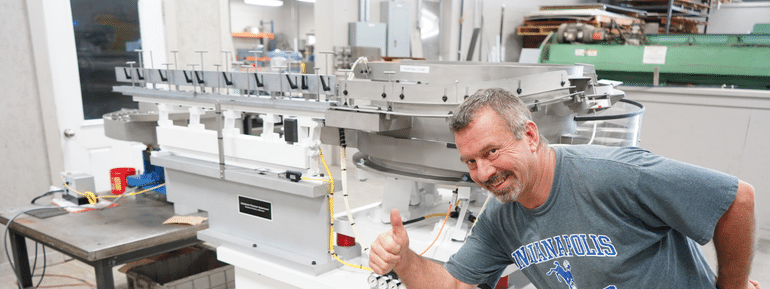Are you thinking of investing in vibratory parts feeding equipment to upgrade or begin your automated process?
Before you do, there are a few questions you may want to consider.

1. Are your parts automation quality?
If you have multiple suppliers and production molds, it’s important to note how much variation there is between parts as these variations can add complexity to feeder solutions. Another factor is material flashing issues or plastic pieces that hang off of some or all of the parts. To be a right fit for a feeder application, it’s important to have a consistent part. Take care to communicate mold release coatings, lubricants and any other substances that might be left on the parts. Seemingly minor variations in production parts must be carefully accounted for when designing a successful vibratory feeder system.
2. Do you have any equipment layout constraints?
Sometimes equipment must be sized specifically to fit into a facility or production line. Depending on the part and available space, we may have to take additional design consideration to fit your feeder into a specific space. We can provide two- or three-dimensional drawings of our proposed system, which helps to address layout concerns.
3. What is your feed rate?
The feed rate is the rate of part output your assembly machine requires to run effectively. When designing your feeder, our goal is to produce a rate to exceed your rate requirements as a buffer. If you determine your system needs to process 100 parts per minute, we need to design a feeder that feeds 120 parts per minute to overcome any potential interruptions and allow your system to run at its highest potential.
4. What is your part orientation?
The size and shape of your part will impact orientation and so does weight and the laws of physics. The orientation of your part is crucial to building an efficient vibratory system. Perhaps your part requires an added track to feed a part to meet system requirements. By understanding part orientation, we can improve efficiency, reduce steps, and increase the overall efficiency of a system.
5. What is your timeline?
The more we understand your overall build cycle of equipment, the better we can plan for design and assembly of your system. Another factor: how the role of your feeder system relates to a broader manufacturing or assembly plan.
6. What is your budget?
As with any project, how much you can spend will be a major factor. You must assess whether to build a sophisticated assembly, or a lean cell with operator assist. You must also consider your up-front costs versus the total cost of ownership for your feeder system. Your budget will help dictate what you hope to accomplish.
7. How are parts being supplied to the feeder?
Vibratory feeder systems do not operate properly if they are too full of parts or starving for parts. Your system should be designed to meter part delivery to the feeder at a proper speed to reduce the number of operators touches and interactions. Your system should also be designed to ergonomic requirements and safety needs. You do not, for example, want a hopper six feet off the ground when your operators are five feet tall.
8. Is there a design specification document or package of documents?
Design specification documents clearly define the expectations surrounding what the customer needs in a vibratory system. These documents cover topics like performance expectations, required features, preferred components, recommended color scheme, sound limitations, and much more. All of these are important to communicate early in the build process.
Hoosier feeder company is your parts feeding solution, and we’ll help you through the process, but if you’ve asked yourself these 8 questions you’ll be that much closer to a successful project.
August 9th, 2021
Related Topics: Vibratory Feeders